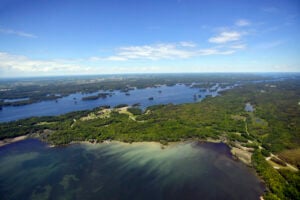Illustration credit: Melville Island viewed from Cowie’s Hill looking toward Halifax. (Illustration: George Parkyns)
Today, it’s home to the tony Armdale Yacht Club, but Halifax’s Melville Island hasn’t always had such a leisurely, tranquil air about it. Brian Cuthbertson, editor of the Journal of the Royal Nova Scotia Historical Society and author of Melville Prison and Deadman’s Island: American and French Prisoners of War in Halifax 1794-1816, explains more about the island’s history as a quarantine site, prison and military barracks.
Quarantine site
A group of 727 of former black slaves known as the Chesapeake Blacks, from the Chesapeake Bay area in the United States, were sent to Melville Island for quarantine between April and July of 1815. An average of 39 per day were admitted to the prison’s hospital with smallpox and typhus.
Those diseases also afflicted the 1,200 Irish who arrived in Halifax from May to October of 1847, after fleeing the Great Famine. The board of health at the time ordered all incoming Irish to be quarantined. That also meant the people treating them — two doctors and a nurse — weren’t allowed off the island. After the hospital closed in October, the board of health reported that 203 Irish patients had been admitted to the fever hospital, and that 30 had died. The rest were discharged.
Prison life during the War of 1812
I have a chapter on this in my book called ‘This day we embarked for hell’, which was from a poem by a soldier on Melville Island.
The prisoners began their day at sunrise, when the jailer opened the barracks and called “Turn out, turn out,” and each man would lash up his hammock and carry it into the yard for roll call. They’d take out the night tub and wash it and open the windows —they were very strict about hygiene.
They were then given their daily rations — one pound of bread, one pound of beef and a quarter pint of peas — which they cooked themselves. But the American agent who was resident in Halifax and also responsible for the prisoners provided them with coffee, sugar, potatoes and items such as soap. They were also given some cash so that they could purchase candy apples, lobsters, smoked herring and spruce beer.
They were allowed to do whatever they wanted during the day — they gambled a lot — but they were responsible for their own discipline. If one prisoner stole from another prisoner, they formed what amounted to a court, and the person would be tried then whipped.
Off to the Crimea
There was a plan concocted, largely by Joseph Howe — the province’s railway commissioner and future premier — whereby American men would be engaged for employment on railway construction in Nova Scotia. This was a deception, as they were really being recruited as part of a foreign legion to serve in the Crimean War. When the recruits arrived in Nova Scotia, they were accommodated at Melville Island, which also served as a processing depot before they departed for England.





